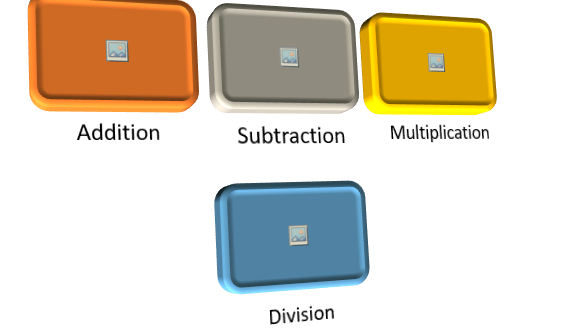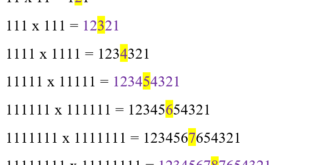In the realm of mathematics, mastering the four fundamental rules of arithmetic operations is essential for solving a wide range of problems. These rules—addition, subtraction, multiplication, and division—are the building blocks of mathematical calculations. In this comprehensive guide, we’ll explore these rules in detail and discuss various types of numbers to deepen your understanding of mathematics.

Mathematics forms the cornerstone of countless fields and disciplines, and at its heart lie the four fundamental rules of arithmetic operations: addition, subtraction, multiplication, and division. These fundamental operations are the bedrock upon which mathematical problem-solving is built. In this comprehensive guide, we will delve into these rules, gaining a thorough understanding of each. Additionally, we will explore different types of numbers, each with its own unique characteristics, providing you with a holistic view of the mathematical landscape.
Arithmetic Operations and Their Significance:
Before we embark on our journey to understand the fundamental rules of arithmetic, let’s take a moment to appreciate the significance of these operations in our daily lives. Whether you’re calculating your monthly expenses, determining the cooking time for a recipe, or solving complex engineering problems, arithmetic operations are at play. They are the language of mathematics that allows us to quantify, measure, and analyze various aspects of the world around us.
Now, let’s dive into the four fundamental rules that underpin arithmetic:
1. Addition (+): Addition is the process of combining two or more numbers to find their total. It’s represented by the plus sign (+). For example, when you add 3 and 5, you get 8. Addition is commutative, meaning that changing the order of the numbers doesn’t affect the result. In other words, 3 + 5 and 5 + 3 yield the same sum, 8.
2. Subtraction (-): Subtraction involves taking away one number from another to find the difference. It’s represented by the minus sign (-). For instance, subtracting 4 from 7 gives you 3. Unlike addition, subtraction is not commutative. In this case, changing the order of the numbers will yield different results. 7 – 4 is not the same as 4 – 7.
3. Multiplication (x or ): Multiplication is the process of repeated addition. It allows you to find the result of adding the same number multiple times. Multiplication can be represented by the “x” symbol or an asterisk (). For example, 3 multiplied by 4 is 12, which can be expressed as 3 x 4 or 3 * 4. Multiplication is also commutative, so 3 x 4 is equivalent to 4 x 3.
4. Division (/): Division is the operation of splitting a number into equal parts or groups. It’s represented by the division sign (/). When you divide 8 by 2, you get 4. Division is not commutative, similar to subtraction. In this case, reversing the order of the numbers will yield different results. 8 / 2 is not the same as 2 / 8.
Understanding the properties and applications of these fundamental arithmetic operations is essential for solving mathematical problems accurately and efficiently. Whether you’re working with whole numbers, fractions, decimals, or even complex mathematical expressions, these rules remain constant and serve as the foundation of all mathematical calculations.
Types of Numbers and Their Characteristics:
To fully grasp the world of mathematics, it’s crucial to acquaint ourselves with various types of numbers, each with its own set of properties and characteristics. Here are some key categories of numbers:
1. Even Numbers: Even numbers are those that are divisible by 2. Examples include 2, 4, 6, and 8. They are characterized by the absence of a remainder when divided by 2.
2. Odd Numbers: Odd numbers are not divisible by 2 and always leave a remainder of 1 when divided by 2. Examples include 3, 5, 7, and 9.
3. Prime Numbers: Prime numbers are integers greater than 1 that are only divisible by 1 and themselves. Examples of prime numbers include 2, 3, 5, 7, and 11.
4. Composite Numbers: Composite numbers are positive integers greater than 1 that have divisors other than 1 and themselves. For instance, 4, 6, and 9 are composite numbers because they can be divided evenly by numbers other than just 1 and 4, 6, and 9, respectively.
5. Whole Numbers: Whole numbers encompass all positive integers, including zero (0). They form a complete set of numbers without fractions or decimals. Examples include 0, 1, 2, 3, and so on, including their negative counterparts: -1, -2, -3, and so forth.
6. Natural Numbers: Natural numbers, often referred to as counting numbers, are the set of positive integers used for counting and ordering. These numbers begin at 1 and continue infinitely: 1, 2, 3, 4, 5, and so forth.
7. Rational Numbers: Rational numbers are those that can be expressed as a fraction, where the numerator (p) and denominator (q) are integers, and q is not equal to zero (q ≠ 0). Examples of rational numbers include 3/5, -3/5, 0/4, 2/-5, and -3/7.
8. Irrational Numbers: Irrational numbers cannot be expressed as fractions. They are decimal numbers that continue infinitely without repeating. Examples of irrational numbers include √5, √5 + √3, and π (pi).
9. Real Numbers: Real numbers encompass both rational and irrational numbers. They are represented on the real number line, which extends infinitely in both directions. Real numbers are used to describe quantities and measurements in the physical world.
In conclusion, arithmetic operations and an understanding of different types of numbers are fundamental to mathematics. These concepts serve as the building blocks upon which more complex mathematical ideas and calculations are constructed. Whether you’re performing basic calculations or exploring advanced mathematical theories, a solid grasp of these fundamental principles is invaluable.
Arithmetic operations – FAQ
Q1: What are the four fundamental rules of arithmetic operations? A1: The four fundamental rules of arithmetic operations are addition, subtraction, multiplication, and division. These operations form the foundation of mathematical calculations and are essential for solving a wide range of mathematical problems.
Q2: Are addition and multiplication commutative operations? A2: Yes, addition and multiplication are commutative operations. This means that changing the order of the numbers being added or multiplied does not affect the result. For addition, a + b is the same as b + a. Similarly, for multiplication, a x b is the same as b x a.
Q3: Are subtraction and division commutative operations? A3: No, subtraction and division are not commutative operations. Changing the order of the numbers in subtraction or division will yield different results. For subtraction, a – b is not the same as b – a. For division, a ÷ b is not the same as b ÷ a.
Q4: What are even and odd numbers? A4: Even numbers are those that are divisible by 2 and leave no remainder when divided by 2. Examples include 2, 4, 6, and 8. Odd numbers, on the other hand, are not divisible by 2 and always leave a remainder of 1 when divided by 2. Examples include 3, 5, 7, and 9.
Q5: What is the difference between prime and composite numbers? A5: Prime numbers are positive integers greater than 1 that are only divisible by 1 and themselves. Examples include 2, 3, 5, and 7. Composite numbers are positive integers greater than 1 that have divisors other than 1 and themselves. For instance, 4, 6, and 9 are composite numbers because they can be divided evenly by numbers other than just 1 and 4, 6, and 9, respectively.
Q6: What are rational and irrational numbers? A6: Rational numbers can be expressed as a fraction, where the numerator (p) and denominator (q) are integers, and q is not equal to zero (q ≠ 0). Examples of rational numbers include 3/5, -3/5, 0/4, 2/-5, and -3/7. Irrational numbers, on the other hand, cannot be expressed as fractions. They are decimal numbers that continue infinitely without repeating. Examples of irrational numbers include √5, √5 + √3, and π (pi).
Q7: What is the significance of real numbers? A7: Real numbers encompass both rational and irrational numbers. They are used to describe quantities and measurements in the physical world and are represented on the real number line, which extends infinitely in both directions. Real numbers play a crucial role in various scientific and mathematical applications.
Q8: Why are these fundamental rules and types of numbers important? A8: These fundamental rules of arithmetic operations and the understanding of various types of numbers are essential for solving mathematical problems accurately and efficiently. Whether you’re performing basic calculations in everyday life or tackling complex mathematical theories, a solid foundation in these principles is crucial. They provide the tools and language to quantify, measure, and analyze various aspects of the world around us.
Other reaources on Maths or General studies are here.
What is number system? Know here.
 IT2EDU Empowering Education Through Technology
IT2EDU Empowering Education Through Technology


